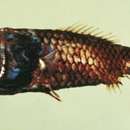mk
имиња во трошки


Poromitra crassiceps, commonly called the crested bigscale (also called large-headed midnight fish, crested melamphid, or one-horned melamphaid[2]) is a species of deep sea fish in the ridgehead family.
While the fish with the common name crested bigscale in Alaskan waters had formerly been identified as P. crassiceps, it is now believed that Alaskan crested bigscales are actually Poromitra curilensis, and that P. crassiceps is restricted to the Atlantic Ocean.[3] As a result of this mis-identification, P. crassiceps is occasionally identified as the largest ridgehead - while specimens of P. curilensis as large as 18 cm SL[4][5] have been found, the maximum length of P. crassiceps is 14.8 cm SL.[6]
Although almost no light penetrates to the deep sea from the surface, the crested bigscale has evolved features that make it practically invisible. Like other deep sea fish, it needs to avoid being seen by predators, some of which hunt for prey by creating their own light by means of bioluminescence. The crested bigscale achieves invisibility by having a skin that absorbs light with great efficiency. The pigment melanin is crammed into granules which are grouped into melanophores which cover virtually the whole of the dermis. This absorbs almost all of the incoming light, and any remaining light that scatters sideways is absorbed by neighbouring granules. The melanophores also cover the big scales, but these detach easily, and any predator that gets close enough, may end up with a mouthful of scales. Altogether, the absorption of light is 99.5% efficient, a fact that makes photographing this fish in its natural habitat very difficult.[7]
Poromitra crassiceps, commonly called the crested bigscale (also called large-headed midnight fish, crested melamphid, or one-horned melamphaid) is a species of deep sea fish in the ridgehead family.
While the fish with the common name crested bigscale in Alaskan waters had formerly been identified as P. crassiceps, it is now believed that Alaskan crested bigscales are actually Poromitra curilensis, and that P. crassiceps is restricted to the Atlantic Ocean. As a result of this mis-identification, P. crassiceps is occasionally identified as the largest ridgehead - while specimens of P. curilensis as large as 18 cm SL have been found, the maximum length of P. crassiceps is 14.8 cm SL.
Although almost no light penetrates to the deep sea from the surface, the crested bigscale has evolved features that make it practically invisible. Like other deep sea fish, it needs to avoid being seen by predators, some of which hunt for prey by creating their own light by means of bioluminescence. The crested bigscale achieves invisibility by having a skin that absorbs light with great efficiency. The pigment melanin is crammed into granules which are grouped into melanophores which cover virtually the whole of the dermis. This absorbs almost all of the incoming light, and any remaining light that scatters sideways is absorbed by neighbouring granules. The melanophores also cover the big scales, but these detach easily, and any predator that gets close enough, may end up with a mouthful of scales. Altogether, the absorption of light is 99.5% efficient, a fact that makes photographing this fish in its natural habitat very difficult.
Poromitra crassiceps es un pez abisal que pertenece a la familia Melamphaidae.[2] Se encuentran en el Océano Atlántico y miden aproximadamente 14,8 centímetros SL.[2]
Esta especie fue reconocida por primera vez en 1878 por Albert Günther.[3]
Poromitra crassiceps es un pez abisal que pertenece a la familia Melamphaidae. Se encuentran en el Océano Atlántico y miden aproximadamente 14,8 centímetros SL.
Esta especie fue reconocida por primera vez en 1878 por Albert Günther.
Poromitra crassiceps Poromitra generoko animalia da. Arrainen barruko Melamphaidae familian sailkatzen da.
Poromitra crassiceps Poromitra generoko animalia da. Arrainen barruko Melamphaidae familian sailkatzen da.
Poromitra crassiceps est une espèce de poissons abyssaux de la famille des Melamphaidae.
Poromitra crassiceps est une espèce de poissons abyssaux de la famille des Melamphaidae.
Poromitra crassiceps is een straalvinnige vissensoort uit de familie van grootschubvissen (Melamphaidae).[1] De wetenschappelijke naam van de soort is voor het eerst geldig gepubliceerd in 1878 door Günther.
Bronnen, noten en/of referenties厚头犀孔鲷(学名:Poromitra crassiceps)为輻鰭魚綱奇鯛目大鱗鲷科犀孔鲷属的鱼类,俗名犀孔头鲷。
本魚分布于西太平洋和大西洋热带以及琉球海沟等。[1]
水深164至2730公尺。
本魚體延長粗壯,頭大且不具稜角、硬棘,眼大,尾部的分岔很淺;胸鰭長長度超過頭部。體呈黑色,鰓條骨8根。在身體與鰓蓋上的鱗片大部份不見,背鰭硬棘3枚;背鰭軟條12至13枚;臀鰭硬棘1枚;臀鰭軟條9至10枚;脊椎骨27至29枚,體長可達14.8公分。
不具任何經濟價值。

カブトウオ(学名:Poromitra crassiceps、シノニム:P. cristiceps)は、クジラウオ目カブトウオ科に属する魚類の一種である。
太平洋などの深度200~2000m付近の深海に生息するとされ、寒海水域では、比較的浅い場所にも進出することもある。
名前の由来は体長の1/3ほどもある厳つい頭部にあり、近縁のキンメダイ科のオニキンメにも似た黒い体色だが、体長は小さく、最大でも14cmほどで、捕獲される時も10cm以下の種類が殆どである。
カブトウオ科には5属36種が含まれる。種類の多さから、大型の深海生物の重要な餌の地位にあると思われる。餌は主にプランクトンや小魚、皆脚類などの浮遊性甲殻類など。